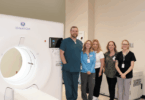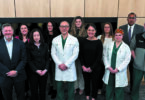UHS offers a wide array of services for people dealing with opioid or other substance use disorders, building on its long history of expertise and commitment to treatment. In fact, when UHS was established in 1981, it included a medically managed detox center, which had opened in 1978 and was the first of its kind in the community. From there, UHS would go on to provide the community with a number of other “firsts,” including the first inpatient rehab clinic in 1982 and the first intensive outpatient clinic in 1987.
Timeline
1978–81
UHS establishes medically-managed detox center
1982
UHS opens first inpatient rehab unit
1987
UHS starts first intensive outpatient clinic
1989
UHS assumes operation of methadone clinic from Broome County
2001
UHS combines its inpatient detox and rehab units
2013
UHS expands its Binghamton methadone clinic capacity to 150
“That first official program set the stage for UHS to go on to develop the inpatient rehab and the full outpatient services,” says Alan Wilmarth, administrative director for Behavioral Health at UHS, who has been with UHS for 36 years. “Throughout the decades, we’ve tried to build the most robust continuum of care we could.”
Mr. Wilmarth attributes the success of UHS’ current programs to this history, as well as strong leadership with a clear vision for treating substance use disorders.
“Our key leaders’ commitment to this population has been strong and has never wavered,” he says. “Even through times when providing [substance use] services wasn’t a popular thing to do, UHS did it, and we did it in a way that maintained us as a good neighbor.”
This has allowed UHS to service its community with a multidisciplinary approach to the opioid crisis. More recently, UHS has been the first in the community to have certified addiction medicine physicians and was also a founding partner in the drug treatment court program with Broome County (see Opportunity for Treatment).
“I can’t stress enough the importance of our team, social workers, counselors, doctors and support staff who all work diligently to keep people engaged in the course of treatment, literally from the first phone call,” says Mr. Wilmarth. “Because patients with substance use disorders are historically difficult to maintain in treatment—that compulsion to relapse is so strong—engagement is the name of the game, and we work very hard at that.”
BY THE NUMBERS
While UHS has a long history of treating people with substance use disorders, the opioid crisis has caused the number of people being treated to grow exponentially in the past few years. Here are some of the ways the patient population is growing:
- 7,596: Number of outpatient services visits in 2017 as of April
- 88 percent: Methadone volume growth from 2010 to 2016
- 79 percent: Inpatient rehab growth from 2010 to 2016
- 86.5 percent: Increase in substance use disorder patient presentation at the UHS Binghamton General Hospital Emergency Department from 2016 to 2017
- 59: Opioid overdoses in March 2017 at UHS Binghamton General Hospital Emergency Department







